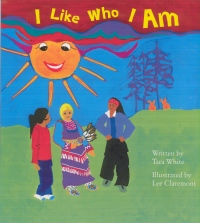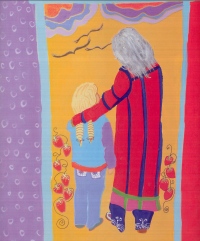| ________________ CM . . . . Volume XV Number 10. . . .January 9, 2009 
 | I Like Who I Am. Tara White. Illustrated by Lee Claremont.
Penticton, BC: Theytus Books, 2007.
40 pp., pbk., $12.95.
ISBN 978-1-894778-63-3. Grades 2-6 / Ages 7-11.
Review by Keith McPherson.
***½ /4 | | | | 
excerpt: The next day as Celine and Heather played in the schoolyard, Becky walked up to Celina and said, "What are you doing here? You are not Mohawk."
"Yes I am," said Celina. "I have a Mohawk name that means, 'the Creation is complete.' I am Mohawk," Celina said.
"I don't care if you have a Mohawk name that means 'the Creation is complete.' You have blond hair and blue eyes. You are not Mohawk,"
I Like Who I Am is a story about an elementary-aged girl named Celina who moves with her mother to her mother's Mohawk reserve, and who experiences peer prejudice related to her physical features. After readers observe Celina being told repeatedly by a brown-haired and brown-eyed girl that she, Celina, is not Mohawk (because of Celina's blue eyes and blond hair), readers become privy to even a greater struggle which Celine faces – a struggle with self-doubt. It is this self-doubt which eventually drives Celine to stop participating in the reserve's powwow, to stop dancing with her friends in the Iroquois Smoke Dance, and to turn her back on her heritage. However, Celine's grandmother comes to Celine's aid and explains that "Being Mohawk is not about how you look. It's about the way you live your life, your knowledge and beliefs in our culture. It is about what is in your heart." Unlike what happens in many picture books about racism, the author, Tara White, moves the story well beyond the usual you-can't-judge-a-book-by-its-cover moral. That is, after accepting her grandmother's definition of what constitutes 'being Mohawk,' Celine draws upon this newfound information and strength and decides to take action and express her 'Mohawk-ness' by participating in the reserve's powwow and by ignoring angry looks from Becky who is in the audience. Ironically, after the dance, Celine observes a group of children bullying Becky. They pick on Becky due to her due to her inability to dance and speak Mohawk. Again, Celine draws upon her grandmother's wisdom and decides to take action by intervening in the bullying and promising to teach Becky how to be/become Mohawk.
Although the book contains multiple strengths, clearly there are three that stand out from the rest. First, the story is written succinctly and illustrated so clearly that readers of many ages can access the story and easily relate to the pain, suffering, and self-doubt that comes from receiving prejudiced comments based on one's physical traits. Second, the story offers hope and optimism to those being bullied, as is illustrated in the way Celine used her inner strength to ignore and overcome bullying. And third, although the story is set in a Mohawk reserve, (and thus would easily appeal to children living in a similar setting or thinking about moving to such a setting), the story is built on exploration into the dynamics of universals (i.e., prejudice and racism) familiar to many children. The majority of children listening to, or reading, this story will easily relate to Celine's situation (the bullied), and/or Becky's situation (the bully), and/or the bystanders (those not stopping the bully), and/or all three situations. The result is a message that educators, councilors, and parents can easily use with a wide variety of primary and intermediate children wishing to explore topics such as: prejudice, community, bullying, family, and positive identity development.
 Claremont's illustrations are dynamic, bursting with vibrant colour, have a Ted Harrison element about them, and provide very clear facial and body clues into the emotional state of the main characters. For example, Becky's eyebrows are dark and furrowed when she's reprimanding Celina; Celina's body is hunched over when being berated by Becky; and Celina's mouth is clearly turned down and she's leaning dejectedly against a wall when she makes the tough decision to forgo the powwow. Additionally, Claremont adds very obvious red and orange jagged lines around Becky's body when she's mad, tear-like ripples spread out from Becky's feet when she cries, and the facial expressions on the sun in the sky reflect the situations created between the characters. Claremont's illustrations are dynamic, bursting with vibrant colour, have a Ted Harrison element about them, and provide very clear facial and body clues into the emotional state of the main characters. For example, Becky's eyebrows are dark and furrowed when she's reprimanding Celina; Celina's body is hunched over when being berated by Becky; and Celina's mouth is clearly turned down and she's leaning dejectedly against a wall when she makes the tough decision to forgo the powwow. Additionally, Claremont adds very obvious red and orange jagged lines around Becky's body when she's mad, tear-like ripples spread out from Becky's feet when she cries, and the facial expressions on the sun in the sky reflect the situations created between the characters.
Claremont's visuals could be used with younger grades to explore elementary colour theory such as primary colors, and warm and cool colors. Older grades would enjoy exploring how Claremont deliberately used multiple visual clues to add meaning to the storyline and the character's actions and emotional states.
Running I Like Who I Am though my word processor's readability calculator finds it has an independent readability level of mid-grade three. The repetitive nature of Becky's comments also creates narrative hooks on which younger readers can hang their comprehension. At the same time, I believe the rising tension between Becky and Celina will make this an engaging read for many grade six students and some grade sevens. I read this story to several urban-Vancouver grade one and five students and found both groups responded well to the story. Both groups were keen to talk about the bullying situations that they had experienced firsthand and which paralleled Becky's and Celine's situation. One astute child noted that Becky and Celine's friends did little to stop Becky's bullying and that these same children were the first to bully Becky! Such comments indicate to me that White and Claremont have deftly place their fingers on the pulse of what is important to children with regard to prejudice and racism, making this story an excellent resource for stimulating conversations around many aspects of the bullying triangle.
An outstanding book ideal for helping grades three to six children begin exploring: 1) the concept of culture, 2) the dynamics and pitfalls associated with judging/bullying others based on their physical features, and 3) the value of taking action against bullies who judge others by how they look. Highly Recommended. Keith McPherson has been a primary and elementary teacher and teacher-librarian in BC since 1984 and is currently the coordinator of the Language and Literacy Education Research Centre at the University of B.C. 
To comment on this title or this review, send mail to cm@umanitoba.ca. Copyright © the Manitoba Library Association. Reproduction for personal use is permitted only if this copyright notice is maintained. Any other reproduction is prohibited without permission. NEXT REVIEW | TABLE OF CONTENTS FOR THIS ISSUE - January 9, 2009. AUTHORS | TITLES | MEDIA REVIEWS | PROFILES | BACK ISSUES | SEARCH | CMARCHIVE | HOME |

 Claremont's illustrations are dynamic, bursting with vibrant colour, have a Ted Harrison element about them, and provide very clear facial and body clues into the emotional state of the main characters. For example, Becky's eyebrows are dark and furrowed when she's reprimanding Celina; Celina's body is hunched over when being berated by Becky; and Celina's mouth is clearly turned down and she's leaning dejectedly against a wall when she makes the tough decision to forgo the powwow. Additionally, Claremont adds very obvious red and orange jagged lines around Becky's body when she's mad, tear-like ripples spread out from Becky's feet when she cries, and the facial expressions on the sun in the sky reflect the situations created between the characters.
Claremont's illustrations are dynamic, bursting with vibrant colour, have a Ted Harrison element about them, and provide very clear facial and body clues into the emotional state of the main characters. For example, Becky's eyebrows are dark and furrowed when she's reprimanding Celina; Celina's body is hunched over when being berated by Becky; and Celina's mouth is clearly turned down and she's leaning dejectedly against a wall when she makes the tough decision to forgo the powwow. Additionally, Claremont adds very obvious red and orange jagged lines around Becky's body when she's mad, tear-like ripples spread out from Becky's feet when she cries, and the facial expressions on the sun in the sky reflect the situations created between the characters.